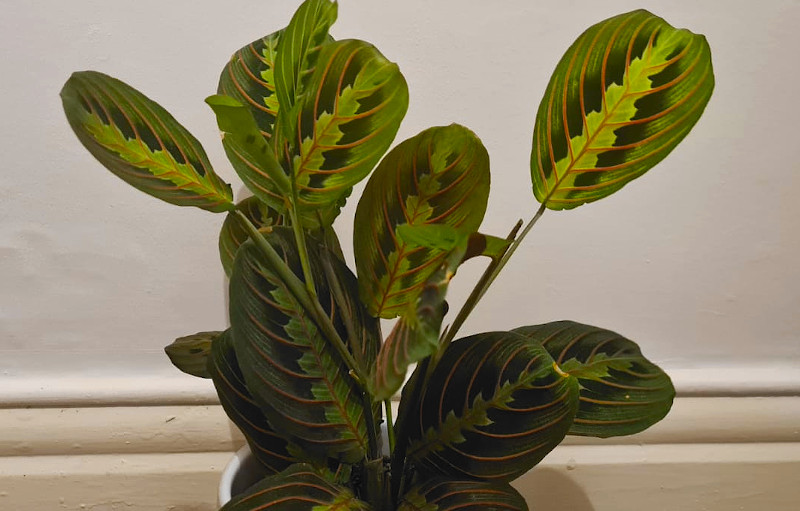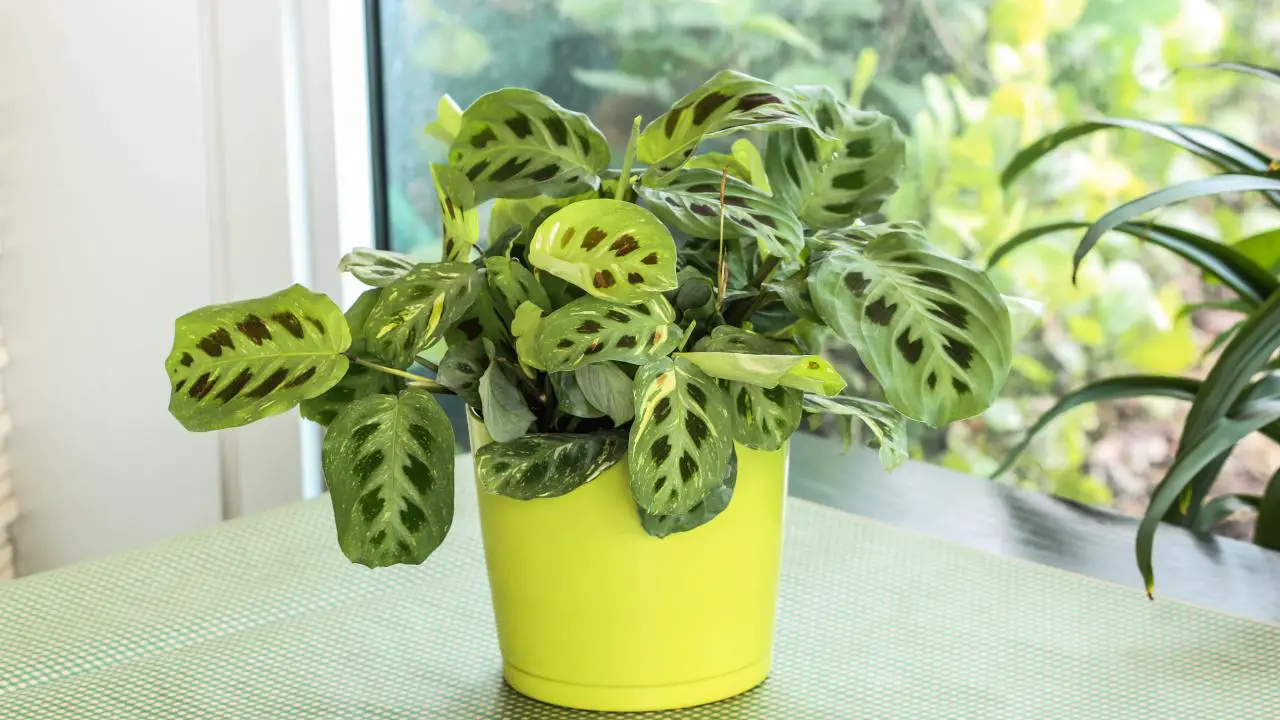Prayer plants require proper care to remain lush green houseplants. Keep the soil moist in Summer while partially drying it out during Winter.
Locating what is causing the plant to suffer is key in revitalizing it. It could be anything from low humidity levels to an inadequate watering schedule.
Watering
The prayer plant is a popular indoor gardening choice. This houseplant features stunning leaves with silvery splotches on a dark background that creates an eye-catching design. While these houseplants may seem easy to care for, their care needs need to be addressed if they want it to survive long term. If neglected for too long or mistreated improperly they could die quickly!
As soon as your prayer plant begins to droop or hang limply from its stems, that’s often an indicator of lack of water. To save this precious plant from dying out completely, ensure its soil remains moist but not saturated; you can test this level by inserting your finger into the top inch of soil; if dryness occurs quickly then more water may be necessary; but be wary about leaving too much moisture for too long as that could cause root rot to set in.
An ideal soil for healthy prayer plants consists of rich, well-draining soil that is slightly acidic. To create this ideal environment, mix equal parts of peat moss, vermiculite and perlite together in equal portions before adding slow release fertilizer for maximum growth potential. Also check drainage holes regularly as these can become blocked over time due to compacted soil build-up.
Low humidity is often the reason behind prayer plants’ decline and wilt. You can quickly increase moisture in the environment around them by placing them near a humidifier or pebble tray. Just make sure never to spray water directly onto their leaves as doing so could cause fungal infections as well as attract pests!
If your prayer plant is experiencing more serious health issues, you may need to uproot and repot it with fresh soil in order to provide it with all of the vital nutrients it requires for good health and vitality. After repotting it in fresh soil, make sure that you water thoroughly after each repotting to ensure the soil doesn’t dry out too quickly; additionally monitor for signs of disease like yellowed or brown leaves on its leaves.
Light
If your prayer plant has fallen on hard times, there are steps you can take to revive it. First step should be identifying what has caused its demise – overwatering, lack of light, pest infestation or something else altogether could all contribute to its decline. Once identified, take appropriate actions and watch as your plant flourish again!
As soon as your prayer plant begins to show signs of overwatering, take immediate steps to assess its soil. Overwatering can cause root rot and damage – to avoid this make sure the soil is completely dry before adding any extra moisture with watering cans or by using a soil probe which provides accurate readings of moisture levels in soil and alerts you when its time to water again.
One issue many people experience with prayer plants is insufficient lighting, leading to leaf loss and slow growth. To combat this issue, try providing more indirect bright light or moving your plant somewhere brighter; marantas, calatheas and ctenanthes tend to flourish in indirect bright lighting – this mimics their native rainforest environment and they prefer indirect sun such as what can be found there; therefore they make excellent houseplants for sunny windowsills.
However, too much direct sunlight may cause its leaves to turn yellow or even burn as prayer plants cannot tolerate extended exposure to direct sun. To save your plant from this fate, move it to an area with lower light intensity while still receiving some sun.
Last, it is essential to monitor the temperature of your plant. Prayer plants thrive in warm environments such as kitchens or bathrooms where humidity levels can remain high – thus ideal conditions exist for them.
Once again, it’s essential that any dead leaves on your prayer plant be promptly removed in order to halt disease or insect infestation that could potentially threaten its survival and kill off its leaves altogether.

Humidity
Prayer plants are tropical in origin and thrive best under humid conditions; therefore it is important to create the same conditions at home. Too little humidity can lead to root rot in prayer plants. To restore their health and restore them to health quickly, increase humidity levels in their environment while providing plenty of light.
Overwatering prayer plants is one of the primary issues they experience, as this will cause damage to their roots. If your plant appears drooping or wilted, check for waterlogged clumps in its soil that need removing to help rehydrate properly – this should enable the plant to begin looking better quickly!
Be mindful of how much water you’re giving the plant. Your plant will tell you if it needs more by drying out; but, if this becomes severe, the drought could kill it completely. To avoid this situation, water the soil regularly enough so it remains moist but not saturated or boggy; consider investing in a moisture probe that allows you to test its moisture levels prior to watering it.
Pest infestation is another serious threat to prayer plants. They’re especially prone to spider mites and aphids, both of which can quickly lead to their demise and should be kept at bay with horticultural neem oil spray – this will kill off any pests while simultaneously stopping their spread to other plants.
Be sure to provide regular feedings of houseplant fertilizer to the prayer plant, which requires many nutrients for healthy growth and revival. Apply this particular Marantaceae safe fertiliser once every other week throughout the year for best results; just remember it’s quite fragile so take precautions if needing to move it around. With these simple steps, your prayer plant could quickly return from dormancy!
Temperature
Prayer plants are tropical plants that flourish under high humidity conditions. When exposed to dry air or soil that does not drain well enough, prayer plants may suffer irreparable damage and even die; with the right care however, these prayers can often be restored back to health again.
Marantaceae plants such as prayer plants require moist but not waterlogged soil for optimal health, due to their sensitive roots that become waterlogged if there is too much humidity. Indoor growers should ensure the soil can drain quickly so as to prevent root rot that often leads to prayer plant wilt.
Avoid this issue by selecting a light, loose soil mixture. This will allow roots to drain freely while keeping moisture levels constant – an ideal mix would include 40% peat moss, 40% perlite, 20% orchid bark and 10% potting soil.
Use of an appropriate soil mixture can also decrease the risk of overwatering, which is important when raising prayer plants. Too much water can cause root rot that kills prayer plants. Furthermore, overwatering may result in fungal infections damaging leaves and stems of your plant resulting in dull and lifeless appearance.
Another likely reason for prayer plant wilting is being placed directly in sunlight. Since they’re native to rainforests, prayer plants (and other Marantaceae) prefer indirect lighting over bright direct illumination. If it is currently near a window that provides direct light exposure, relocate it for optimal results.
Wilting prayer plants could also be suffering from pest infestation. Mealybugs, aphids, and spider mites can be responsible for this situation; regular inspection of plants for signs of these insects should help. Furthermore, maintaining optimal humidity levels will help deter their return.
Wilting prayer plants could also be experiencing salt or chemical buildup in their soil, which may occur if it has been overfertilized, or is in an old pot without adequate drainage facilities. In such an instance, it would be wise to repot them with new soil mixture and an updated pot with better drainage facilities.

